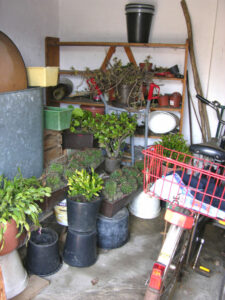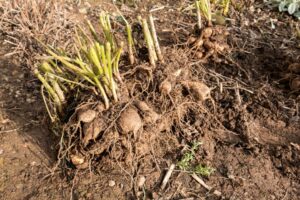==================
A Caveat and Affiliates
First off, a little caveat: within my articles you will find affiliate links, meaning if you buy them, I get a small commission. Your cost is not affected. In addition, I am an Amazon Associate and I earn from qualifying purchases on Amazon.
And yes, if I say that I recommend a product here, it means I truly believe it is a good product. I refuse to recommend any product that I have not researched and believe to be a good value.
Even better, I provide you with a very clear picture of the product, it’s use, and the probable value.
Earning your trust is important to me. I run this website myself and the commissions and donations help support the site.
Sound reasonable and fair enough? Let’s continue to the article.
==================
By overwintering, you can keep your favorite plants alive for years. During winter, it’s a custom to stock plants indoors for safekeeping. This practice of overwintering is easy and cost-effective if done in the right way.
As winter approaches, consider what expert gardeners do to preserve plants successfully in the cold season. But before that, let us take a deep dive first into what overwintering means.
What is overwintering? Overwintering is a way of conserving non-hardy plants from killing frost and freezing temperatures. Your storage for safekeeping may depend on how big and what type of cold-sensitive plant you have. Some can stay indoors to become houseplants, while others need cool, dark spaces like potting sheds and basements to undergo dormancy.
Whatever the case, overwintering plants can save you the cost and the hassle of finding replacements for the plants that succumbed in winter. Identifying what plants to keep and what they need is the key to successful overwintering.
Plants that need Overwintering
Surely you have one or more tropical plants lying on your garden bed and balcony. As you know, all tropical plants can take the heat, but not all can tolerate freezing temperatures. In fact, most of them are highly sensitive to cold weather.
When planning to overwinter a tropical plant, there are two things you need to consider. (1) Plants that can be kept as houseplants, (2) Plants that need a dormant period. Here are some examples of plants for indoors:
- Hibiscus
- New Zealand flax
- Plumeria
- Begonias
- Impatients
- Geraniums
- Cannas
- Dahlias
- Tarragon
Plants that undergo dormancy commonly have bulbs, tubers, or corns. Here are some examples of plants that can be overwintered to experience the dormancy period:
- Sweet potato vine
- Angel’s trumpet
- Cannas
- Dahlias
- Lilies
- Elephant ears
- Four o’clocks
- Banana plant
- Pepper plants
Nearly all non-hardy plants can thrive in temperatures around 40 degrees. Some can survive frost for short periods. But most get damaged due to freezing temperatures. These plants do not have a winter resistance skill in their natural cycle, hence, many die during winter. Despite this, however, the cold season is perfect for overwintering and for promoting dormancy.
How to Overwinter Plants
Reserve a Good Space

Some plants should be brought indoors
To overwinter plants, place them in a cool, dark room with temperatures below 60°F. It will enable plants to detect winter even if not outside. Ideal choices for safekeeping include unheated or minimally heated rooms, basements, attic access, crawl spaces, garage, and outbuildings like root cellars and potting sheds.
For plants that are sensitive to moving, covering them with straws, or compost can protect them from the cold. Avoid using leaves as covering as they mostly get too heavy and will flatten perennials and other pants.
Depending on the size of the plants, you can layer as much as 6 to 18 inches deep. Surround the covering with wire or other types of fencing and secure it to keep the materials in place. Wait until plants are fully dormant and before the ground freezes, typically early to mid-November. By this time, soil temperature has stabilized. Too soon may prevent plants from overwintering.
Clean Up Clay Pots, Fabric Pots, and Containers
Since most of the plants’ lives are spent outdoors, it is expected for pots to accumulate salt deposits and bug eggs. To clean pots and containers, start by cutting dead plant parts and emptying the soil. Now you can set aside your plant or temporarily scatter it in your yard.
Then, scrape and wipe the pots to make sure there are no residues left. After that, use a vinegar solution to soak the plants for a few hours. In this way, you can kill off bug eggs, and disease spores, as well as wash away soil salinity and algae. Once you’re finished, rinse pots thoroughly and dunk them in clean water. Afterward, place pots in direct sunlight to dry. When dry, check any unwanted deposits and remove them.
For fabric pots, the soil must be removed. Start by scooping out some of the soil, then simply dump the rest. Next, soak the bags in a bucket of water mixed with bleach detergent. Now rinse the fabric pots thoroughly and hang them to air dry.
Don’t Over-water Bulbs

If you have plants that grow bulbous roots (sometimes referred to as corns and tubers), it indicates they’re dormant plants. A dormant plant can be overwintered easily.
Start by cutting all the foliage and carefully digging the bulbs out of the soil. Let the bulbs dry out for several days. Then pack them in newspaper with peat moss, sawdust, or coco husk. Put them in boxes and store them in a dark, cool room until spring. They should be loose enough to allow ventilation and retain enough moisture to prevent getting bone dry.
Since fleshy bulbs hold moisture, they only need a small amount of supplemental water. You can let the boxes dry out the entire winter or dribble it with water a few times a week. But be careful to not overdo it, as can cause rot, mold, and fungal growth. If you noticed any rotting, soft, or dried-out bulbs, simply remove them.
Prune Overwintering Plants
Trim back stalky plants that grew huge to move them indoors. However, you must do this before cold weather hits. Start trimming in the fall before the first frost—around early to mid-September.
Pruning helps boost flowering and make sure that shrubs and foliage don’t outgrow their space. Large plants, especially those that become trees, make indoor space limited and may not be ideal to grow as house plants.
Allow Overwintering Plants to Rest

Most plants can stay dormant for a long period. You can control when the plants should start resting by moving them to a cool and dark room. Plants can be overwintered in a garage or basement. Then, in late winter, gradually move your plants into a sunny spot to prepare them for spring.
Avoid Drastic Changes in the Environment
Plants respond to sudden changes in temperatures by activating heat shock factors that will stop plants from resting. To avoid this, cover your plant’s old blanket or flannel sheet. Covering also helps regulate temperature and block light that might confuse the resting plants. Keeping the environment cool can make plants stay hibernate or dormant in winter.
Keep in touch
Some perennials don’t need to stay indoors for long but only during the frost months. You might end up losing your overwintering plants if you forgot them for too long.
In late winter or a month or two before spring, you can repot your plants and let them until spring. Best to start with new soil each spring even though plants did not get a disease from the previous soil. Or, wait until after the last frost and replant them directly on your garden bed.
Final thought
Overwintering plants can go either through success or failure. Remember that not all plants grow equally, and some ways can be better than others. So, for this reason, be prepared to lose a few plants in the process.
